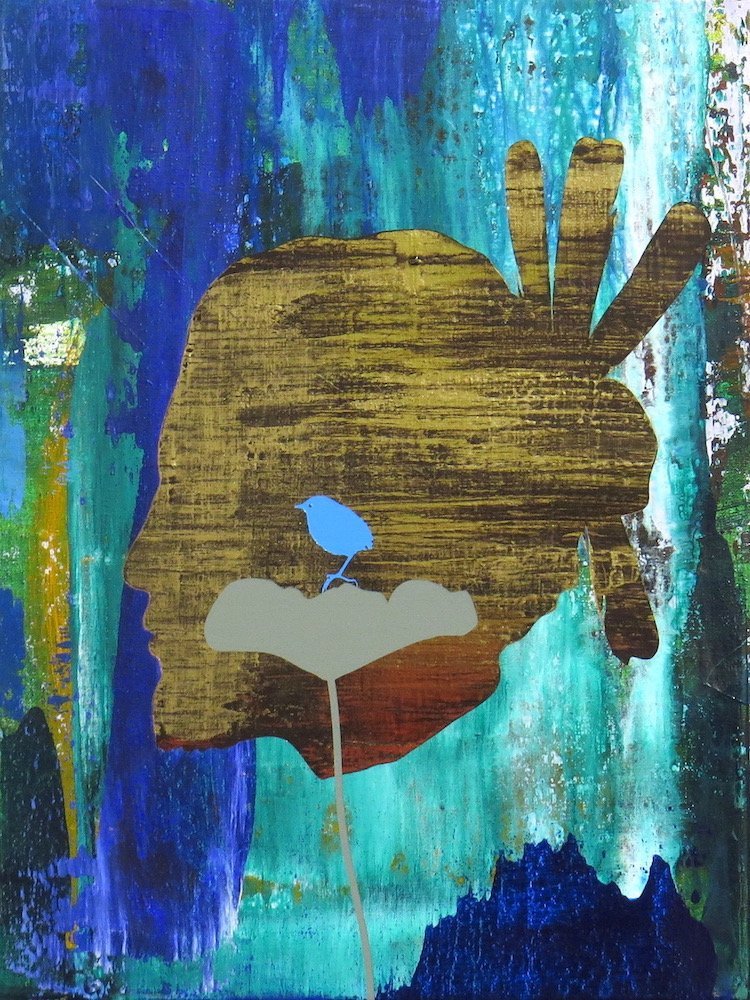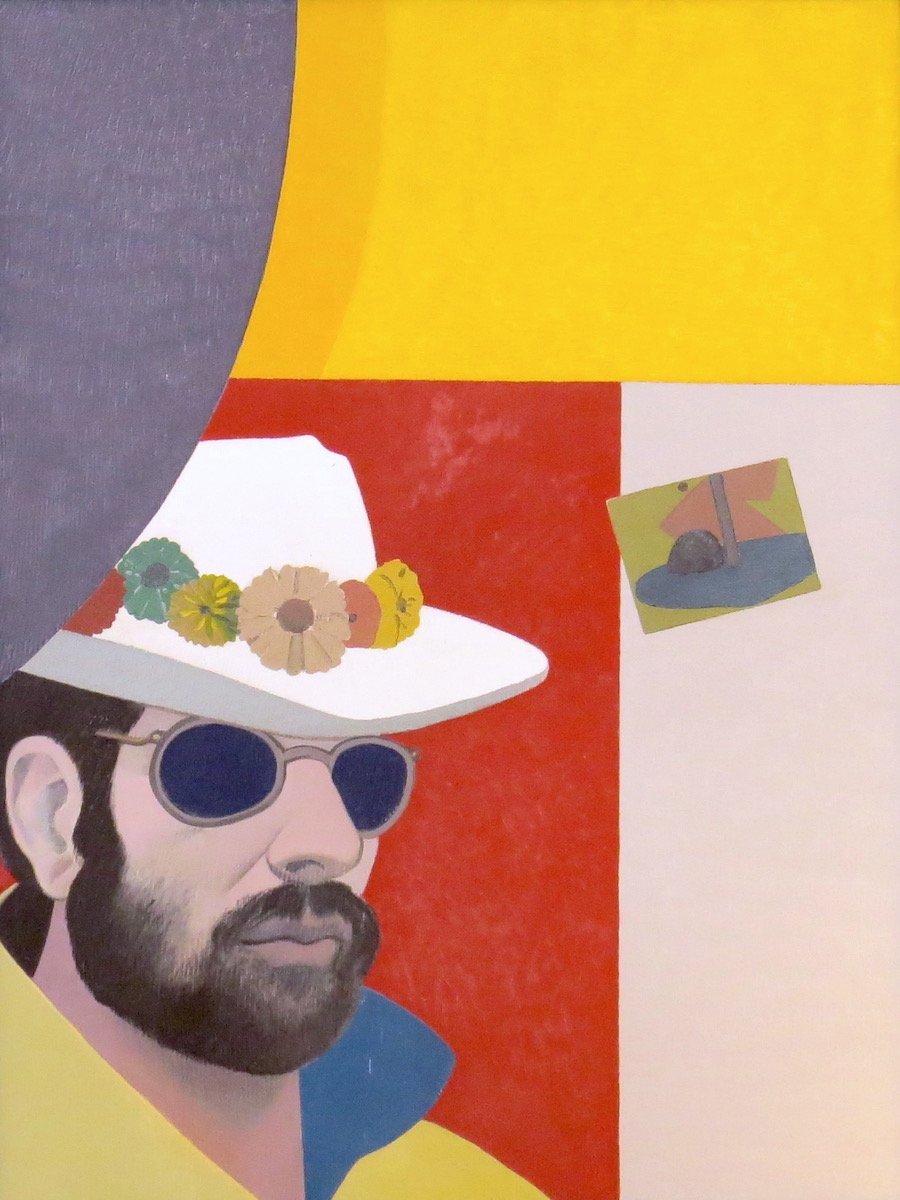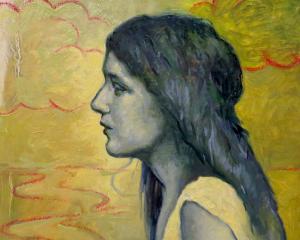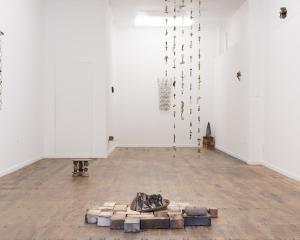
(Milford Gallery)
Chris Heaphy’s art employs the motif of large silhouettes to create montages.
Maori heads, plants, feathers, birds and vessels are used as symbolic markers, together creating a wordless concept of New Zealand. It is a New Zealand which straddles the divide between Maori and Pakeha, between physical and spiritual, and between the natural and the artificial.
There is a marked change in emphasis and style in Heaphy’s latest exhibition. Whereas previous work has focused solidly on black silhouettes, placing them against plain or softly gradated backgrounds, in the latest exhibition both the silhouettes, and especially the backgrounds, have taken on a strongly painterly dimension. There is a bold gestural abstraction to the broad sweeps of colour and metallic paint. Backgrounds are streaked with strong washes, predominantly running the length of the canvas, and silhouettes marked with strokes of paint running at right angles to this.
The effect is to bring a dynamic life to the canvas, accentuated by the vibrant colours used. Gone are the deep russets and pale greys of previous exhibitions; here is vermilion, bright cyan and rich lavender. It is as if Heaphy’s previous works are being viewed while on some psychedelic drug.
The effect is powerful and combines well with Heaphy’s search for identity in a multi-cultural land.

(Brett McDowell Gallery)
Mark Braunias’ art is gently iconoclastic. He uses a surreal abstraction as a vehicle to present art that breaks the rules, as the art establishment might define them.
In his first major exhibition in Dunedin, the Waikato-based artist presents works from "Beneath the Saccharine Underground". The works are exuberant, veering from the darkly subtle to the humorous, and employ such high art "no-nos" as the use of fluorescent paint and the deliberate placing of works against a background made from larger canvases.
Braunias uses the analogy of the Saccharine Underground, a term coined by music magazines to refer to bright pop songs which hide an emotional darkness (think ABBA’s Knowing Me, Knowing You, or The Beatles’ We Can Work It Out). Braunias’ somewhat tongue-in-cheek Manifesto is to challenge the romanticised notions of New Zealand pictorial art, and to focus on the mark-making, and on the meaning of these individual marks. In light of these aims, the work is a question pointed at the viewer — what is my meaning? Musically speaking, less ABBA and more The KLF. How seriously this manifesto is to be taken is up to the viewer, but there is an attractive strangeness to the images which does seem to taunt as much as to tease the viewer.

(Pea Sea Art)
"Home" is an exhibition of works by former Dunedin-based artist Eion Stevens. When Stevens died in 2021, he left instructions for his art to be sold for charity. Knowingly, he arranged for a limited number of works to go on sale every year, so that the market would not be flooded, and the charities would gain maximum benefit. The current exhibition is part of that grand plan, with proceeds going to the Port Chalmers Foundry Society.
Characterised by bold planes of colour and strong lines, the works bring to mind early 20th-century artists such as Charles Demuth, balancing on the edge of futurism and precisionism. There are nods from Stevens towards art from this period and artists ranging from Picasso to James Ensor. This latter acknowledgement provides for one of the exhibition’s highlights, a self-portrait of Stevens wearing a hat featured in one of Ensor’s own self-portraits.
The works are bright and appealing, with many of them — such as Pilot and Come In No. 3 — using minimal line to convey their message with just a handful of blocks of colour. The most affecting of the pieces, however, are three more nuanced works featuring human figures — the previously mentioned self-portrait, Rolling Back The Sky, and the enigmatic The List.
By James Dignan








![Rozana Lee, "Drawn to see(a)" [Installation view]. Photo: Beth Garey](https://www.odt.co.nz/sites/default/files/styles/odt_landscape_small_related_stories/public/story/2024/10/blue_oyster_r_lee.jpg?itok=IGhlKMSl)



![Phaeacia (2024), by Paul McLachlan [detail]. Acrylic and rust on canvas.](https://www.odt.co.nz/sites/default/files/styles/odt_landscape_small_related_stories/public/story/2024/09/paul_mclachlan_phaeacia_de.jpg?itok=UuQsvnQc)